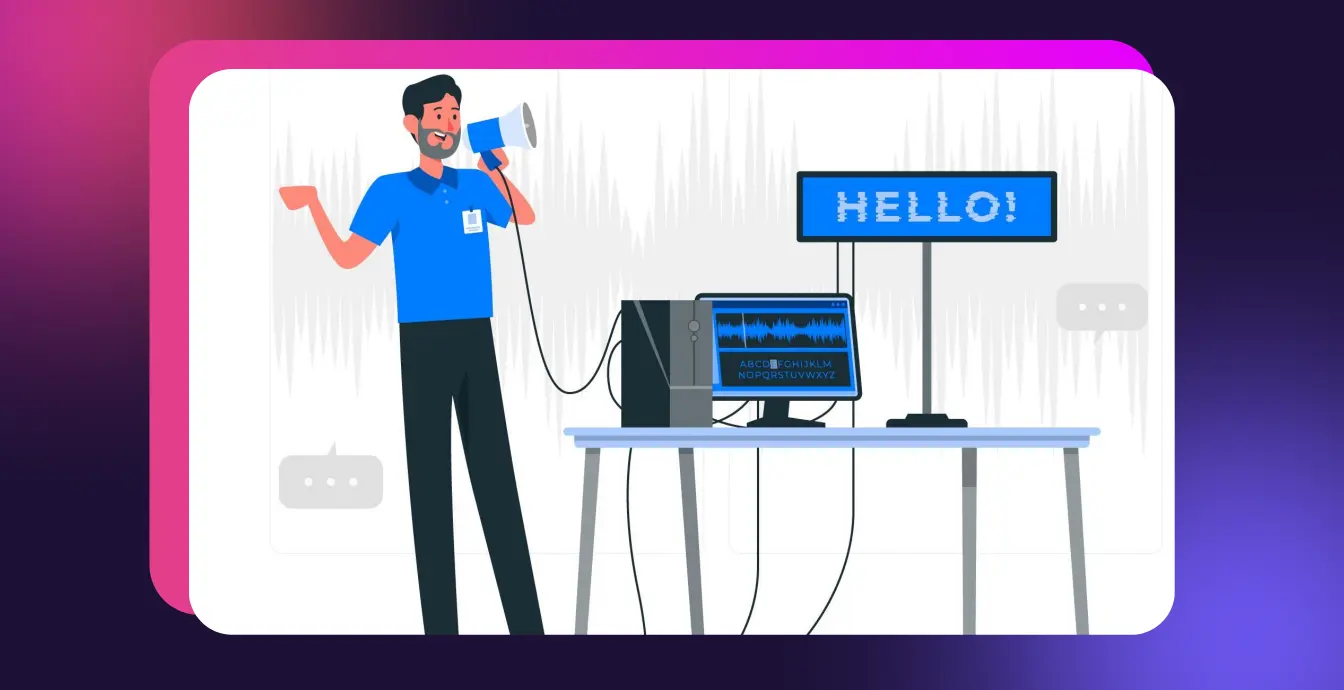How to Use Speech to Text on Windows?

Transform Text into Natural-Sounding Speech in 200+ Voices
Ever found yourself wishing for a tool to effortlessly turn your spoken words into written text? Speech to text for Windows desktop and laptop computers makes this a possibility. Whether you’re a pro needing precise transcriptions or simply looking to save time on document creation, speech to text is your ultimate solution.
This guide will help you unleash the potential of online speech recognition on your Windows device. Discover a world of seamless communication and enhanced productivity with a straightforward walkthrough and practical insights. Let’s get started!
Why Speech to Text for Windows?
With speech to text, users can enjoy a more efficient and streamlined workflow, freeing up their hands and reducing the time spent typing. Additionally, voice to text for Windows enhances accessibility for individuals with disabilities, allowing them to interact with their devices more easily and perform tasks that would have otherwise been challenging on even online web pages.
Efficiency
Typing can be time-consuming. Using voice diction for Windows allows you to get your thoughts on paper more quickly, ensuring a seamless flow of ideas into writing. This helps boost productivity for tasks like document creation, email composition, and note-taking. It is helpful for professionals and students who need to manage large volumes of text.
Accessibility
Voice to text for Windows can assist individuals with physical disabilities or those who find typing challenging to communicate with ease. By providing an accessible avenue for communication, this feature reinforces Windows commitment to inclusivity, ensuring that everyone has an equal opportunity to express themselves without hindrance.
Multitasking
You can speak your thoughts while doing other tasks, making you more productive. The multitasking capability stands out, allowing users to vocalize thoughts while concurrently engaging in different tasks, such as browsing the internet or navigating applications.
This seamless integration of speech recognition software into daily workflows transforms multitasking into a more efficient and streamlined process, going beyond mere convenience and becoming an essential tool for a diverse range of users.
Also Read: How to Maximize Productivity With Speech to Text Software
Getting Started with Windows Speech Recognition
Enabling speech recognition for your Windows Computer is a straightforward process:
Step 1: Open speech recognition
Navigate to the “Speech Recognition” application from the search bar on your device. Here, you can find information about this assistive technology and its uses for Windows. Click ‘Next’ to continue.
Step 2: Set up your microphone
From the listed options, select the type of microphone you use. For best results, opt for a “Headset Microphone.” Click “Next” to proceed.
Step 3: Adjust microphone
Once you have connected your microphone, adjust it for optimal voice capture.
Step 4: Read Aloud: Read the text shown on your screen aloud to help with voice recognition for Windows. Click “Next,” and your voice recognition is ready to use
Step 5: Document Review
Next, you can set up “Document Review” to review the generated text. Here, you can also point out and correct inaccuracies due to accent.
Step 6: Mode of Activation
Now that you are ready to start using voice commands on your device, you can decide what happens when you want it to stop listening. Once you finish your task, you can simply say “Stop Listening” to stop voice recognition.
Step 7: Speech Reference Card
Next, you will be asked if you want to view or print the “Speech Reference Card,” which is a list of commands you can use for voice to text for Windows.
Once you have activated the feature, open the program you want to use or select the text box you want to dictate text into. Your speech will now be converted into text in the text box.

How to Leverage Windows Speech to Text?
Unlock the full potential of Windows speech to text by incorporating voice commands into various aspects of your digital experience. Seamlessly integrate this feature, allowing for diverse actions and enhancing your efficiency and accessibility.
Dictate Text
Use human voice to effortlessly transcribe spoken words into written text. This is invaluable for drafting documents, composing emails, or jotting down thoughts without the need for manual typing.
Command Your Computer
Take control of your mobile devices through natural-sounding speech commands. Execute tasks like opening applications, navigating menus, or initiating system actions with ease, streamlining your overall user experience.
Transcribe Audio
Transform audio files into written text by leveraging the transcription capabilities of Windows speech to text. This can convert spoken words, recorded meetings, interviews, or lectures into text files for easy reference and sharing.
Voice Navigation
Navigate through applications, folders, and websites using voice commands. This hands-free approach to navigation enhances accessibility, especially for users with mobility challenges, providing a more inclusive computing environment.
Voice Search
Harness the power of speech to text for efficient searches. Activate the voice search feature to quickly find files, information on online web pages, or specific applications, saving time and simplifying the search process.
Also Read: Text to Speech vs. Speech to Text
Windows speech to text stands as a transformative feature, ushering in a new era of productivity and accessibility for users across diverse needs and preferences. From time-saving efficiency to accessibility that STT provides for individuals with physical challenges, the impact is profound.
Windows has not just introduced a tool; it has provided a gateway to streamlined communication, efficient multitasking, and an inclusive digital environment. As technology evolves, speech to text will become increasingly pivotal in enhancing user experiences. By embracing and leveraging this powerful feature, users can unlock their Windows devices’ potential, making everyday tasks more intuitive, efficient, and accessible.

Frequently Asked Questions
Is speech to text available on all Windows versions?
.svg)
Speech to text is a standard feature in recent Windows versions, prominently in Windows 10. Its availability, however, varies depending on the specific edition and version.
How to do speech to text in Windows?
.svg)
To engage speech to text for Windows, access Settings,’ proceed to ‘Privacy,’ and select ‘Speech.’ Enable ‘Speech Recognition,’ then follow on-screen instructions for setup, involving reading provided sentences. Verify your microphone configuration and commence using the feature by activating it with the designated hotkey, typically Windows key + H. This initiates a fluid transcription process, offering an efficient and hands-free approach to converting spoken words into written text on your Windows device.
Can Windows 11 do speech to text?
.svg)
Yes, Windows 11 includes built-in features for speech recognition. The process typically involves enabling ‘Speech Recognition’ in the system settings, configuring a microphone, and using the designated hotkey to activate the feature.
How do I add voice to text in Windows 10?
.svg)
To add voice to text in Windows 10, go to ‘Settings,’ select ‘Privacy,’ and then choose ‘Speech.’ Turn on ‘Speech Recognition,’ follow the setup instructions, and confirm your microphone settings.














